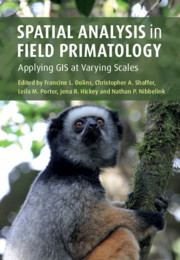Book contents
- Spatial Analysis in Field Primatology
- Spatial Analysis in Field Primatology
- Copyright page
- Dedication
- Contents
- Contributors
- Acknowledgments
- 1 Why Place Matters, and its Use in Primate Behavioral and Ecological Research
- Part I GPS for Primatologists
- Part II GIS Analysis in Fine-Scale Space
- Introduction
- 7 Home Range Analysis
- 8 Quantifying Resource Dispersion in Free-Ranging Bearded Sakis in Guyana
- 9 Interpreting Small-Scale Patterns of Ranging by Primates
- 10 Determining the Presence of Habitual Travel Route Networks in Orangutans (Pongo pygmaeus morio) in Kutai National Park, Borneo
- 11 Finding Fruit in a Tropical Rainforest
- 12 Random Walk Analyses in Primates
- 13 The Use of Small-Scale Spatial Analysis to Evaluate Primate Behavior and Welfare in Captive Settings
- 14 The Promise of Spatially Explicit Agent-Based Models for Primatology Research
- Part III GIS Analysis in Broad-Scale Space
- Index
- Plate Section (PDF Only)
- References
8 - Quantifying Resource Dispersion in Free-Ranging Bearded Sakis in Guyana
What Is a Patch?
from Part II - GIS Analysis in Fine-Scale Space
Published online by Cambridge University Press: 29 January 2021
- Spatial Analysis in Field Primatology
- Spatial Analysis in Field Primatology
- Copyright page
- Dedication
- Contents
- Contributors
- Acknowledgments
- 1 Why Place Matters, and its Use in Primate Behavioral and Ecological Research
- Part I GPS for Primatologists
- Part II GIS Analysis in Fine-Scale Space
- Introduction
- 7 Home Range Analysis
- 8 Quantifying Resource Dispersion in Free-Ranging Bearded Sakis in Guyana
- 9 Interpreting Small-Scale Patterns of Ranging by Primates
- 10 Determining the Presence of Habitual Travel Route Networks in Orangutans (Pongo pygmaeus morio) in Kutai National Park, Borneo
- 11 Finding Fruit in a Tropical Rainforest
- 12 Random Walk Analyses in Primates
- 13 The Use of Small-Scale Spatial Analysis to Evaluate Primate Behavior and Welfare in Captive Settings
- 14 The Promise of Spatially Explicit Agent-Based Models for Primatology Research
- Part III GIS Analysis in Broad-Scale Space
- Index
- Plate Section (PDF Only)
- References
Summary
Few concepts are more central to models of primate socioecology than the food patch. Many aspects of primate behavior are thought to be strongly influenced or even constrained by the distribution and quality of food patches, including group size and cohesiveness, daily path length and home range size, activity patterns, social structure, and patterns of agonistic behavior (Chapman & Chapman 2000; Isbell 1991; Koenig 2002; Nakagawa 1989; Sterk et al. 1997; Symington 1988; van Schaik 1989; Vogel and Janson 2007). According to these models, selection for efficient foraging results in grouping and ranging behaviors that allow primates to maximize feeding rates within a patch (Charnov 1976; Schoener 1971; Stephens & Krebs 1986). As a group of foragers begin to deplete a patch, their mean rate of nutrient intake declines due to reduced densities of food items (scramble competition) or contests with other animals (contest competition). As larger patches contain a greater abundance or density of food items, they can accommodate larger foraging groups. For any patch size, however, a point is reached at which the diminishing returns (i.e., reduced rate of nutrient intake) become high enough that it is more efficient to leave and travel to another patch. When this point is reached is determined by the quality of and distance to the other patches available to the forager (Charnov 1976; Schoener 1971). Therefore, much of the discussion of the role resource dispersion plays in the evolution of primate socioecology revolves around the conditions under which patches are monopolizable and/or depletable. For a patch to be monopolizable, it must be relatively small and/or clumped, allowing dominant individuals to limit access of subordinates (Chapman 1990; Strier 1989; White & Wrangham 1988). In addition, a monopolizable patch should be resource-rich (at least compared to the areas surrounding it), making defending it worthwhile for dominant individuals. A patch is theoretically depletable when the feeding activity of an individual or group leads to the disappearance of all food items (Chapman & Chapman 2000; Charnov 1976). However, patches can be considered functionally depleted when the rate of intake for the forager decreases to a level equal to the average for the rest of the environment (Chapman & Chapman 2000; Charnov 1976; Stephens & Krebs 1986).
- Type
- Chapter
- Information
- Spatial Analysis in Field PrimatologyApplying GIS at Varying Scales, pp. 152 - 179Publisher: Cambridge University PressPrint publication year: 2021
References
- 1
- Cited by

